
|
A Vicarious Trip to Florida by Richard L. Howey, Wyoming, USA |
Every year, my sister and her husband leave the frozen winter wastelands of Lincoln, Nebraska and, like birds, migrate south to Florida. This annual event occurs in January or February when there are usually piles of snow, subfreezing temperatures, high humidity, and brutal windchills. I know because I spent my first 21 years in Lincoln. They go to one of the islands that is known for its beach combing, especially for shells. My sister developed a fascination for shells, which she has passed on to her children and hopefully they will pass it on to their children. She, of course, is well acquainted with my eccentric passion for things biological and after every trip she has sent me a parcel containing a delicious assortment of shells. She has learned not to ask me what sorts of specimens I would like, since one year I told her I would like a manatee and the next year I told her I wanted a porpoise. After all, everyone should have a porpoise in life. She has also learned not to take me too seriously.
Some years, the shell assortments have included some very nice little sea urchin tests, so one time I suggested that, if she could find some that had washed up on the beach and still had some spines, I would be interested in having them. That year a parcel arrived with a splendid assortment of shells and a small jar with the remains of a spiny, small sea urchin in it–fresh from the beach, but over a week old from wending its way through the postal system maze from Florida to my front door. As a consequence, a ripe, rancid, robust stench assaulted my nostrils when I removed the lid and I knew immediately that plunging it into alcohol or even formalin was, at this point, useless. My sister had suggested that such a result might ensue and so she was not particularly surprised when I called to thank her for the other shells and report that I had to discard the sea urchin. Fortunately I have since found a couple of other sources for dried sea urchins complete with spines.
This year, when they were planning for their trip, I asked her if, in addition to some of the very lovely, smaller shells, she would keep an eye out for some other sorts of beach debris, such as, bits of sponges or soft corals–with the stringent stipulation that they be thoroughly dry! I always look forward with child-like anticipation to receiving parcels containing natural history goodies and so, when this one arrived, I was especially looking forward to it, since I know that my sister is imaginative and resourceful–and I was not disappointed, even though there was no manatee or porpoise. (Next year I’m going to ask for a whale.)
I began by unpacking the shells and I’ll show you two images of the ones which I think are especially special. I have long been a fan of Murex shells and my sister found a small, lovely specimen with a beautifully fluted edge.

Nature is constantly experimenting and certain results of this astronomical exercise in trial and error are especially pleasing to the human eye. Here’s another type of Murex.

In this case, instead of the delicate edging, we find these long, elegant spines. This shell also has the wonderful popular name of Venus Comb (Murex pecten).
In the box was also a wonderful moon shell (Polinices duplicatus).

Here on the surface, one can discern a kind of tracery in the form of a spiral. Shells are fascinating in so many respects that it requires an entire lifetime just to scratch the surface of their enormous variety. Gastropod shells are of special interest due to the often elegant internal spiral structure of their shells. When I was much younger and had much more energy and still believed that I had an infinite amount of time, I used to take some shells and cut them down their long axis with a jeweler’s saw in order to reveal the inner chambers.
Since then I have discovered a craft supply house that sells shells not only cut in half, but some with cuts on each side of the central axis to produce a slice right out of the middle. I’ll show you a couple of examples of cut shells.


One of the most pleasing of all such preparations is, to my mind, a bisected Nautilus shell.

The elegance of this spiral has inspired many naturalists, mathematicians, and philosophers to write about spiral patterns in nature. Spirals, branching, and symmetrical patterns occur again and again in nature as D’Arcy Thompson pointed out nearly a century ago in his masterful work On Growth and Form.
As an example of branching, I’ll show you a lovely sponge which my sister sent.

When it was alive it may well have had a vibrant, brilliant color. People whose experience with Porifera is limited to bath sponges have little idea of the enormous variety of shape and color which sponges display. Naturally, I wanted to know about the spicules in the sponge. Here is an image of some of them.

These are rather ordinary looking and are short, blunt rods which show little variation.
While we’re on the subject of sponges, there was also a piece from a sponge with orange pigmentation.

This is a closeup of the specimen showing the fine needle-like spicules which cover the surface. It is difficult to imagine even from the larger piece I have what the whole sponge looked like, but clearly if it was a branching type, it had a radically different appearance than our previous specimen. Here is an image of some of its spicules.

These spicules are clearly acicular (needle-like), as you can see, and rather more interesting than the previous ones.
After I had emptied the box, I noticed that there was a small piece of debris still remaining at the bottom. When I removed it and examined it under my stereo-dissecting microscope, I discovered that it too was a sponge fragment. Here are some of its spicules.

Here when I was treating the section with bleach, I stopped the process before all of the tissue had been dissolved. As you can see, the spicules have a lattice arrangement a bit of which remains here.
Although in these examples, we have limited variation among the types of sponge spicules, there are dozens and dozens of different types of spicules.
I’ll show you a couple of other types just to convey the idea.

This sponge has both long rods and spheres. These ovoid spheres come in a variety of sizes and may have a range of projections extruding from their surfaces.

In this close-up the projections are clearly visible.
There are a few species of freshwater sponges. Here is an image of some spicules from one such called Spongilla.
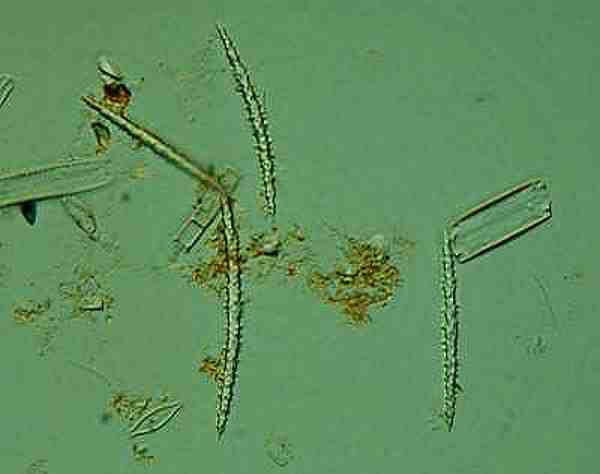
Another type of sponge that has remarkable spicules is the hexactinellid. As the name suggests, their structure is based on having six spines or projections. This is often difficult to discern since these so-called “glass sponges’ tend to fuse masses of spicules together and, in the case, of Euplectella, the Venus Flower basket, form architectural marvels.

A close-up reveals some of the more intricate details of the lattice.
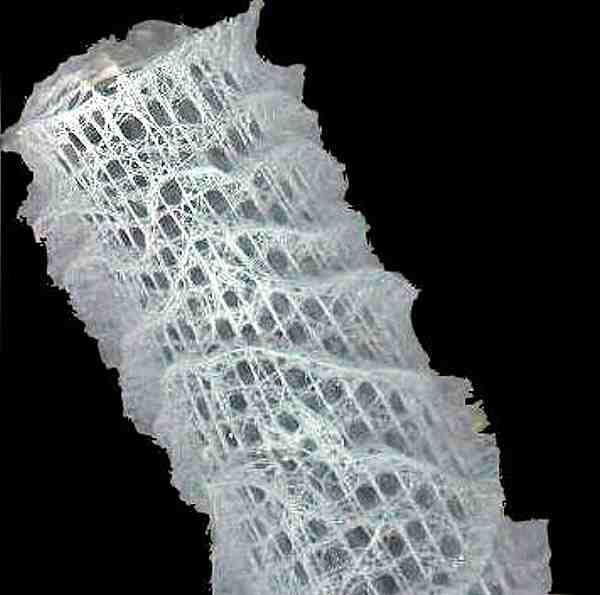
Another type of glass sponge found off the coast of the Philippines is often attached to the shell of Xenophora, also know as the”carrier shell”.

Its lattice is considerably different as you can see from the close-up below.
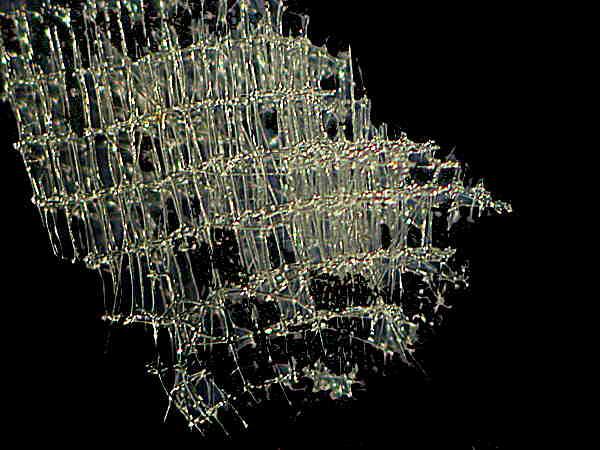
Yet another type of glass sponge has a quite different lattice arrangement as is clear from the image below.
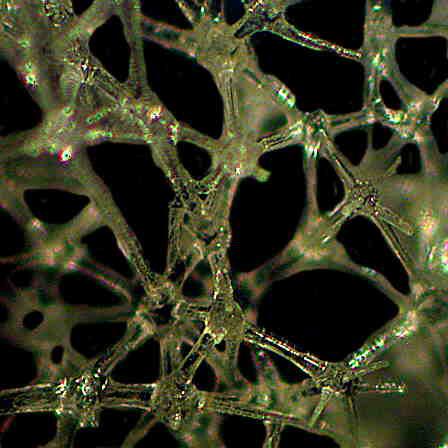
Back to the box of treasures. Included was a 2 ½ inch knob of hard coral which had broken off from a sizeable colony.
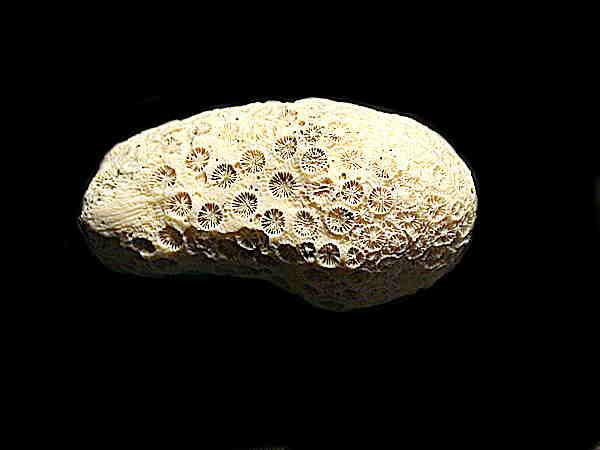
The symmetry of the calcareous deposits where the individual polyps were located is quite impressive.
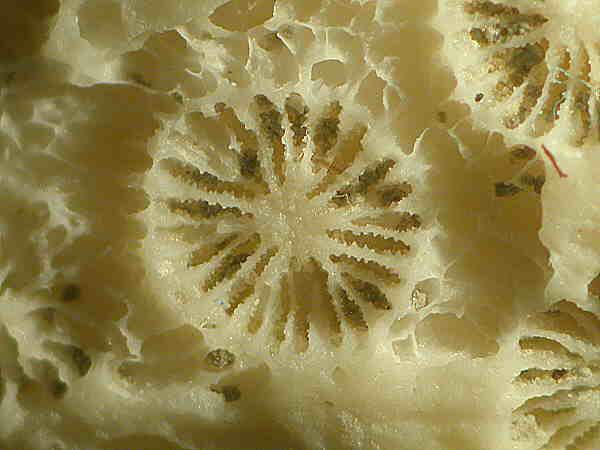
Also included in the box were two pieces of Gorgonian or”soft” coral, one orange and one purple.
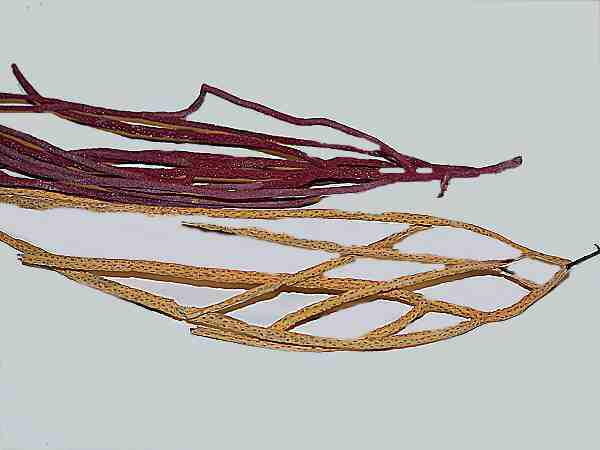
When one has such dried samples, the polyps are, of course essentially obliterated. If one takes a piece of this material and cuts a cross section, you will see a small, dark core at the center surrounded by a dense outer circle of either orange or purple material. (There are also yellow and bright red Gorgonians.) If one scrapes off some of this material and treats it with bleach and then rinses it thoroughly, you will get distinctive spicules such as those in the image below. [Caution: Bleach is highly caustic and dangerous to mucous membranes. Avoid skin contact and inhalation of the fumes.]

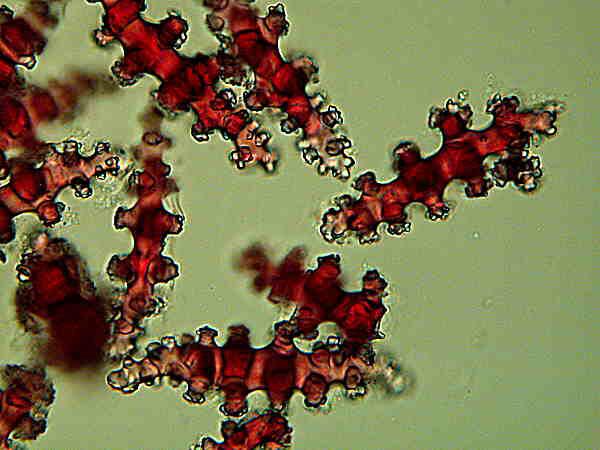
As you can see these are quite different from sponge spicules and the pigment is deeply embedded in the crystalline material of the spicules, since the bleach does not remove it as one might expect.
Yet another item in the box was a small crab carapace. I tend to think of crabs as the court jesters of the marine world; they have a clownish aspect that is both amusing and slightly sinister, especially if you get nipped by the claw of a large one. Their sideways, scuttling movements should certainly make them eligible for a grant from Monty Python’s Department of Silly Walks. This specimen no longer has any appendages, but it is an interesting object nonetheless. If one looks at the carapace under magnification, several fascinating aspects reveal themselves.
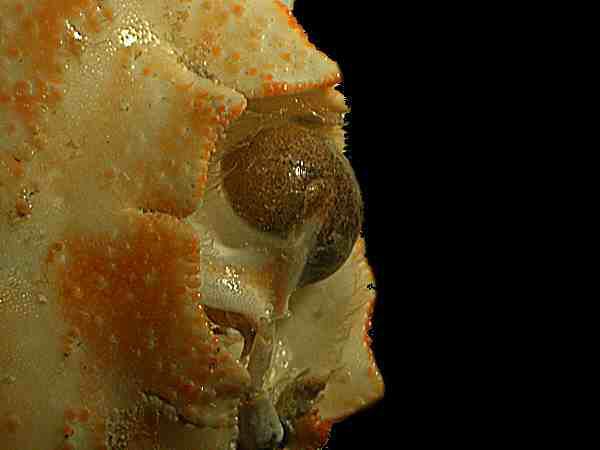
In the image above, we can see the vestiges of one of the eyes. Crabs, like insects, have compound eyes and the structure of eyes in invertebrates is in itself an intriguing subject since they range from mere eyespots to the highly sophisticated eyes of cephalopods, but that’s a subject for another essay.
However, the ultimate treasure in this shipment still remained unwrapped. It was in a plastic grocery store sack. When extracted, its appearance was of a foot-long coil of parchment 3 to 4 inches high, with many small compartments.
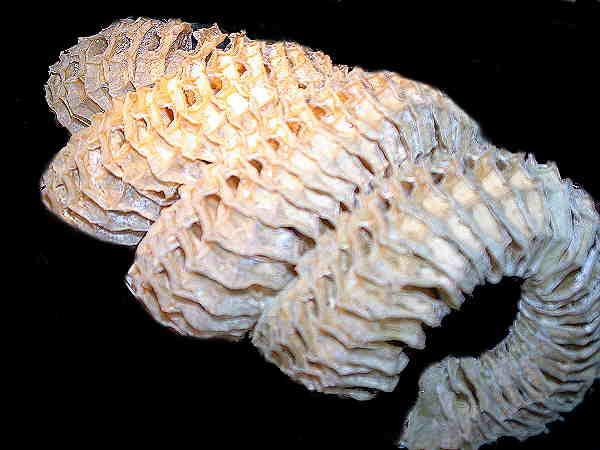
It is the egg case of a whelk. What an elegant marvel! A number of mollusks, among them many nudibranchs, produce spiral egg cases, but to my mind, the whelk egg cases are among the most amazing of all. I shall especially treasure this specimen because of its intrinsic aesthetic beauty and because my sister and her husband found it and were generous enough to send it to me.
I also wish to take this occasion to thank my devoted and extraordinarily talented and tolerant wife for proofreading not only this essay, but some 70 others as well.
I hope that my sister and her husband continue to take seaside trips and continue to not only indulge, but encourage my eccentric interests. (Hint, hint.)
All comments to the author Richard Howey are welcomed.
Microscopy UK Front Page
Micscape Magazine
Article Library
Please report any Web problems or offer general comments to the Micscape Editor .
Micscape is the on-line monthly magazine of the Microscopy UK website at Microscopy-UK